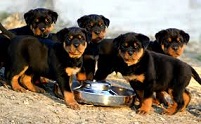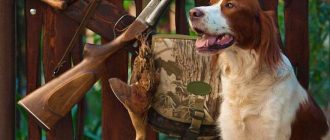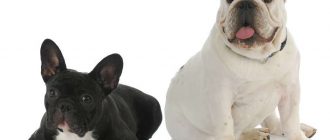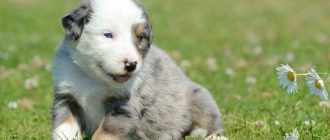Reading up on Rottweiler breeding facts? Discover more about German Rottweiler breeding facts…
German Rottweiler’s suffer from hip and elbow dysplasia. Most of the leading dog breeders recommend that a client only a purchase the puppy that has been certified by the orthopedic foundation for animals in America or the German certification body for Rottweiler’s.
The basic vital statistics of the German Rottweiler breed are as follows: The Rottweiler is black in color and has distinct tan markings over its muzzle, cheeks, eyes, chest and legs. It has a straight and coarse coat of medium length. Interestingly enough since they have double coats, they shed the undercoat twice a year. This is known as a blowout. The general size of the Rottweiler is medium to large and it is a very bulky and heavy dog. The male weighs from 95 – 135 pound and the female weighs between 80 – 110 pounds. The German Rottweiler’s are short and stocky and highly muscular when compared to the American Rottweiler’s which are slightly slender.
History of the German Rottweiler
When it comes to the breeding history the German Rottweiler is said to originate from the mastiff type dog. It is considered to have been bred in the Roman Empire. It is assumed that they accompanied the Roman Army over the Alps, as they were protectors for the Army cattle that was the main food source for the battling armies. Historians believe that the second appearance of this dog came in the southern region of Germany in the town of Rottweil, which lies nestled in the mountains.. Initially the German Rottweiler was used by the farmers who would deliver the milk on their carts and the dogs were good at cattle droving. Following this the butchers also used them to guard the lower levels of the meat shops as well as moving money to and from the banks.
Health Concerns
The Rottweiler started growing in popularity with law enforcement and police works as guard dogs. They can be very loyal and tend to be hostile and aggressive towards strangers. However, most owners describe them as having unique characters that are very gentle. The dog is very happy when it’s occupied in a constructive work environment. It loves to play and needs a very active lifestyle. The German Rottweiler is not a dog to be kept caged in. It is not a very socialized dog and needs to be trained properly in terms of interacting with others. Obedience training is also a must. If you do not look into these considerations the dog can have many behavioral problems and can be a bully, even with the owner’s.
As far as genetic diseases are concerned the German Rottweiler suffers from an elbow joint or hip joint displacement that can be quite expensive to treat. Since this problem is hereditary you must get a certified puppy without the problem. It can over eat so it gets a bloated stomach full of fluid and gas. There can be a problem with stomach distention and it flips over!





